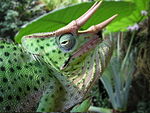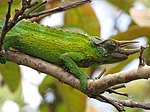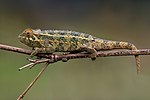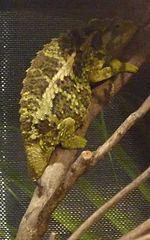| Image | Name | Common Name | Subspecies | Distribution |
| Trioceros affinis
(Rüppell, 1845) | beardless Ethiopian montane chameleon, Rüppell's desert chameleon | | Ethiopia. |
 | Trioceros balebicornutus
(Tilbury, 1998) | Bale two-horned chameleon | | Ethiopia. |
 | Trioceros bitaeniatus
(Fischer, 1884) | side-striped chameleon, two-lined chameleon | | Ethiopia, southern Sudan, Somalia, Kenya, Tanzania, Uganda, and the northeastern Democratic Republic of the Congo. |
 | Trioceros camerunensis
(L. Müller, 1909) | Cameroon dwarf chameleon | | Cameroon. |
| Trioceros chapini
(de Witte, 1964) | Chapin's chameleon,[5] grey chameleon | | Gabon and Democratic Republic of the Congo. |
| Trioceros conirostratus
(Tilbury, 1998) | South Sudanese unicorn chameleon | | South Sudan and Uganda. |
 | Trioceros cristatus
(Stutchbury, 1837) | crested chameleon, fringed chameleon | | Bioko, Equatorial Guinea, Cameroon, Central African Republic, Democratic Republic of the Congo, Republic of the Congo, Gabon, Nigeria, Ghana, and Togo. |
 | Trioceros deremensis
(Matschie, 1892) | Usambara giant three-horned chameleon, wavy chameleon | | East Usambara, Uluguru, Nguu and Nguru Mountains, and Udzungwa Mountains. |
 | Trioceros ellioti
(Günther, 1895) | Elliot's chameleon,[6] montane side-striped chameleon, Elliot's groove-throated chameleon | | Burundi, Kenya, South Sudan, Rwanda, Tanzania, Uganda, and Democratic Republic of the Congo. |
| Trioceros feae
(Boulenger, 1906) | Bioko hornless chameleon, Bioko montane chameleon, Fea's chameleon | | Bioko. |
| Trioceros fuelleborni
(Tornier, 1900) | (named after Friedrich Fülleborn),[7] flapjack chameleon, Ngosi Volcano chameleon, Poroto three-horned chameleon, mountain three-horned chameleon | | Tanzania |
| Trioceros goetzei
(Tornier, 1899) | Goetze's chameleon,[8] Ilolo chameleon, Goetze's whistling chameleon |
- Trioceros goetzei goetzei (Tornier, 1899) – Goetze's whistling chameleon
- Trioceros goetzei nyikae (Loveridge, 1953) – Nyika whistling chameleon
|
Tanzania and Malawi. |
| Trioceros hanangensis
Krause & Böhme [de], 2010 | Mount Hanang montane dwarf chameleon, Mount Hanang chameleon | | Tanzania |
| Trioceros harennae
(Largen, 1995) | Harenna hornless chameleon |
- Trioceros harennae harennae (Largen, 1995) – Harenna hornless chameleon
- Trioceros harennae fitchi (Nečas, 2004) – Fitch's Harenna hornless chameleon[9]
|
Ethiopia |
 | Trioceros hoehnelii
(Steindachner, 1891) | helmeted chameleon, high-casqued chameleon, von Höhnel's chameleon[10] | | Kenya and Uganda |
| Trioceros incornutus
(Loveridge, 1932) | Ukinga hornless chameleon | | Tanzania |
| Trioceros ituriensis
(K.P. Schmidt, 1919) | Ituri forest chameleon | | Democratic Republic of the Congo and Kenya. |
 | Trioceros jacksonii
(Boulenger, 1896) | Jackson's chameleon[11] |
- Trioceros jacksonii jacksonii (Boulenger, 1896) – Jackson's three-horned chameleon
- Trioceros jacksonii merumontanus (Rand, 1958) – dwarf Jackson's chameleon
- Trioceros jacksonii xantholophus (Eason, Ferguson & Hebrard, 1988) – Mount Kenya three-horned chameleon, yellow-crested Jackson's chameleon
|
south-central Kenya and northern Tanzania. |
 | Trioceros johnstoni
(Boulenger, 1901) | Johnston's chameleon,[12] Johnston's three-horned chameleon, Ruwenzori three-horned chameleon | | Democratic Republic of the Congo, Burundi, Rwanda, and Uganda |
| Trioceros kinangopensis
Stipala et al., 2012 | Aberdare Mountains dwarf chameleon | | Kenya. |
| Trioceros kinetensis
(K.P. Schmidt, 1943) | Mount Kineti montane dwarf chameleon, Mount Kineti chameleon | | South Sudan. |
| Trioceros laterispinis
(Loveridge, 1932) | spiny-flanked chameleon | | Tanzania. |
| Trioceros marsabitensis
(Tilbury, 1991) | Marsabit one-horned chameleon, Mt. Marsabit chameleon, Tilbury's chameleon | | Kenya. |
 | Trioceros melleri
(Gray, 1865) | giant one-horned chameleon, Meller's chameleon,[13] Meller's giant one-horned chameleon | | Malawi, northern Mozambique, and Tanzania |
 | Trioceros montium
(Buchholz, 1874) | Cameroon sailfin chameleon | | Cameroon. |
| Trioceros narraioca
(Nečas, Modrý & Šlapeta, 2003) | Mount Kulal chameleon or Mount Kulal stump-nosed chameleon | | Kenya |
| Trioceros ntunte
(Nečas, Modry & Slapeta, 2005) | Mount Nyiru chameleon, Nyiru montane dwarf chameleon | | Kenya |
| Trioceros nyirit
Stipala et al., 2011 | Mount Mtelo stump-nosed chameleon, Pokot chameleon | | Kenya |
 | Trioceros oweni
(Gray, 1831) | Owen's chameleon[14] | | Nigeria in the north, to Angola in the south, and Burundi in the east |
| Trioceros perreti
(Klaver & Böhme, 1992) | Perret's chameleon,[15] Perret's montane chameleon | | Cameroon. |
 | Trioceros pfefferi
(Tornier, 1900) | Pfeffer's two-horned chameleon,[16] Pfeffer's chameleon, Bakossi two-horned chameleon | | Cameroon. |
 | Trioceros quadricornis
(Tornier, 1899) | four-horned chameleon |
- Trioceros quadricornis quadricornis (Tornier, 1899) – southern four-horned chameleon
- Trioceros quadricornis eisentrauti (Mertens, 1968) – Rumpi Hills chameleon
- Trioceros quadricornis gracilior
(Böhme & Klaver, 1981) – northern four-horned chameleon
|
western Cameroon and southeastern Nigeria. |
 | Trioceros rudis
(Boulenger, 1906) | coarse chameleon, rough chameleon, Ruwenzori side-striped chameleon, Rwenzori bearded montane dwarf chameleon | | western Uganda, Rwanda, Burundi, and eastern DR Congo |
| Trioceros schoutedeni
(Laurent, 1952) | Schouteden's montane dwarf chameleon[17] | | Rwanda and Democratic Republic of the Congo. |
| Trioceros schubotzi
(Sternfeld, 1912) | Mount Kenya montane dwarf chameleon, Mount Kenya side-striped chameleon, Schubotz's chameleon[18] | | Kenya |
| Trioceros serratus
(Mertens, 1922) | | | Cameroon |
| Trioceros sternfeldi
(Rand, 1963) | (named after Richard Sternfeld),[19] Crater Highlands side-striped chameleon, Tanzanian montane dwarf chameleon | | Tanzania |
 | Trioceros tempeli
(Tornier, 1899) | Tanzania mountain chameleon, Tempel's chameleon,[20] Udzungwa double-bearded chameleon | | Tanzania |
 | Trioceros werneri
(Tornier, 1899) | Werner's chameleon,[21] Wemer's chameleon, Wemer's three-horned chameleon | | Tanzania |
 | Trioceros wiedersheimi
(Nieden, 1910) | Mount Lefo chameleon, Wiedersheim's chameleon[22] | | Cameroon and Nigeria |
 | Trioceros wolfgangboehmei
Koppetsch, Nečas & Wipfler, 2021 | | | Ethiopia. |
|


















